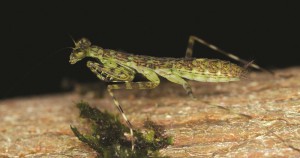
BY ALPER ÖZKAN (MSN/PhD)
d_ozkan@ug.bilkent.edu.tr
Nature loves mantids almost as much as it loves crabs, and this week we’ll be looking at some of its attempts to put mantis claws on various insects, with varying degrees of success.
Belostomatids: Our first not-mantis is a more capable predator than genuine mantids, reaching lengths over 10 centimeters and reputedly preying on small turtles and snakes. These aptly-named giant water bugs are also capable of inflicting an incredibly painful bite, powered not by venom or physical force, but by the fact that their digestive enzymes are also capable of liquefying human flesh. Like those of scorpions, their claws are used to hold their prey in place for the fatal strike—though they deliver the killing blow with the characteristic segmented beak of true bugs rather than a venomous stinger. Other, related water bugs (such as water scorpions and water stick-insects) also possess similar armaments, as do certain assassin bugs—some of the latter even use their claws to pluck spider webs, producing vibrations that imitate snared prey and lure the web’s hopeful occupant into an unexpected doom.
Hangingflies: The most notable feature of scorpionflies is of course the enlarged genital segment that gives the group its name, but this is far from their only claim to fame. Indeed, fleas are in fact highly specialized, wingless scorpionflies (while—and yes, I do feel compelled to mention this at every turn—termites are now recognized as a subgroup of cockroaches, and lice, quite fittingly, are probably derived from booklice; also, insects themselves are quite possibly crustaceans, though writing this still feels so horribly wrong), and one group even evolved raptorial legs…raptorial hind legs, that is. Dangling from vegetation with their front legs, these reverse-mantids catch flying insects from behind with a single, elongated claw on the middle and hind pairs, a predatory tactic that is surprisingly reminiscent of the asanbosam—an African spirit said to hang from trees with its arms and impale unwary travelers on the iron hooks it has in place of feet. This method of hunting does have a drawback, however: although useful for catching prey, the ungainly claws of hangingflies also render these animals nearly incapable of walking.
Flies: While just about every insect order contains some “fly” or other, true flies belong to Diptera and possess only two wings—and they’ve managed to develop raptorial antennae. The larvae of phantom midges, like those of all flies, lack true legs to be modified into claws, but their grasping antennae can lash out to capture small aquatic invertebrates. Some dance flies also have raptorial front, middle or hind legs, though unlike hangingflies, they capture their quarry in flight (this is a specialty of predatory flies, as nothing short of a dragonfly can match the aerial maneuvering capacity of a true fly—some parasitic flies may even oviposit on their hosts in flight, dropping their eggs from above like bomber planes), while the shore fly Ochthera digs into the sand with its clawed front legs to snatch the larvae of other flies (the shore flies are also notable for having among their number the petroleum fly, Helaeomyia petrolei, which I’ve mentioned here before—but when an animal manages to live in crude petroleum, it deserves to be mentioned as often as space permits).
 Mantidflies: Related more closely to lacewings (green, net-winged insects that you’ve no doubt seen around at Bilkent, and major predators of the aphids that swarm the campus every year) than actual flies, the imagines of these bizarre insects hunt more or less like mantids—but the larvae are worse than the adults. These lace-winged predators often begin their lives as parasitoids in the young of insects or spiders, and their eggs may hatch into mobile planidium larvae that actively seek spider eggs to devour. Some are even known to board adult spiders, wait patiently for them to spin an egg sac—and then sneak into it to feast on the eggs.
Mantidflies: Related more closely to lacewings (green, net-winged insects that you’ve no doubt seen around at Bilkent, and major predators of the aphids that swarm the campus every year) than actual flies, the imagines of these bizarre insects hunt more or less like mantids—but the larvae are worse than the adults. These lace-winged predators often begin their lives as parasitoids in the young of insects or spiders, and their eggs may hatch into mobile planidium larvae that actively seek spider eggs to devour. Some are even known to board adult spiders, wait patiently for them to spin an egg sac—and then sneak into it to feast on the eggs.
Actual mantids: Am I alone in thinking these things don’t really get the respect they deserve? I mean, the garden variety is a stock character in every bug movie, and devil and orchid mantids are quite famous nowadays, but that’s not the end of mantis diversity! You have desert-dwelling mantids that hide among the sands, brown-gray mottled mantids that mimic trees and lichen, stick-like mantids that ambush from branches and ground mantids that run after their prey (this is something I’ve recently learned, and it really is quite a shock, since a mantis that runs fast is like a flying shark or a T-rex with long arms), and mantis nymphs come in an equally bizarre array of forms. It is also notable that many mantids can hear—but these auditory cyclopes only do so through a single fused ear.
Crustaceans and various other arthropods also have a strong raptorial appendage game going on (mantis shrimps, for starters, have made quite a name for themselves with their bullet-speed “punches”), but this will be it for now—into another column they will go.
